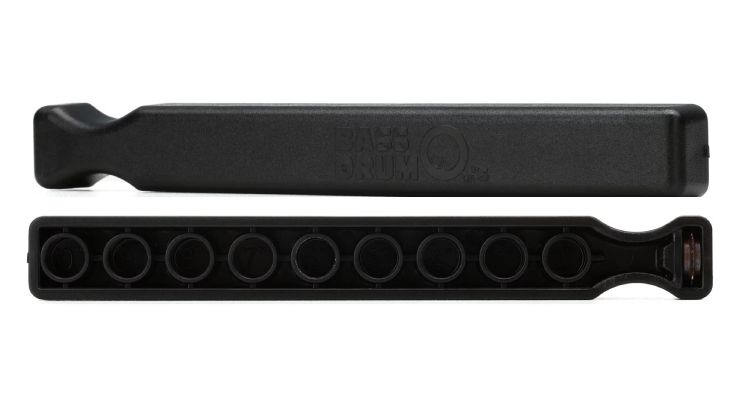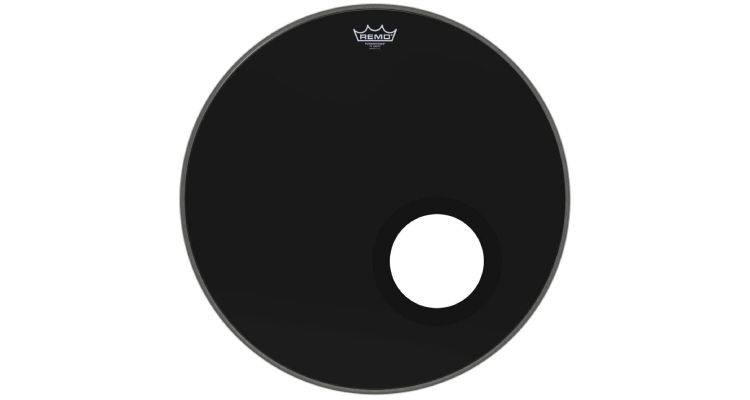When looking at drum kits, you’ll often see two distinct types of bass drums. Some have holes in the front head, while others don’t.
The hole that you see in the resonant heads of some bass drums is referred to as a port hole, and the inclusion of one affects the bass drum in several ways.
In this guide, I’m going to explain what the point of having a hole in a bass drum head is, and I’ll explain how to add your own one to a drumhead that doesn’t already have it.
I’ll also give a few suggestions of drum heads that already have port holes for those who aren’t into the DIY side of drum gear.
Contents
Should You Have a Kick Drum Port Hole?
Having a port hole in your resonant head is optional, as some drummers don’t require all the benefits that port holes bring to the table.
You’ll find that most drum kits to buy don’t have port holes in the bass drums, so it’s often easier to just forget about it and use whatever you already have to work with.
If you want to have a port hole in your bass drum, you’ll either need to cut one out of the resonant head that you already have or you’ll need to purchase a new resonant head that has one built into it.
I’d say that the benefits of having a port hole outweigh the benefits of not having one, so you should aim to have a port hole if you want the most playability and potential out of your bass drum.
What Does a Port Hole Do on a Bass Drum?

Having a port hole on a bass drum affects it in several ways. The biggest one is that it allows access to the inside of your bass drum without having to remove the resonant head.
This means that you can place a bass drum microphone inside the bass drum to achieve a particular sound in the mix when recording drums. It also means that you can place muffling inside the bass drum a lot easier.
In terms of tonal differences, you get a bit more definition from your beater when the resonant head has a port hole.
That articulation gets boosted even further when a microphone gets placed inside the kick. The bass drum sound is also a bit brighter.
Lastly, you’ll get less rebound from your bass drum beater when playing a bass drum with a port hole. The energy from the resonant head gets released as opposed to bouncing back at you, so you’ll get a tighter feel, which many drummers love.
Here’s a quick summary of the differences to look back on as a reference:
Bass Drum Port Hole vs No Porthole
Port Hole
- Punchier bass drum sound
- Easier to add muffling to the bass drum
- Allows you to place a mic inside the bass drum
- More articulation and attack
- Less rebound from the bass drum beater
- More control when recording drums
No Port Hole
- How most resonant heads come with drum sets
- Warmer bass drum sound
- More rebound from the bass drum beater
- More durable (port holes add more potential for the head being ripped)
Making Your Own Bass Drum Port Holes
Placement
Before making cutting a hole in a resonant bass drum head, you need to map out where you want it to be.
The best places would be either the lower left or lower right of the head, as placing it anywhere else may cause a bit of frustration in the long run.
If you place the holes on the upper part of the resonant head, you won’t be able to use a dedicated kick drum mic stand, as it will be too short. They’re all designed to fit nicely into a port hole that is near the bottom of the head.
You also should never cut a port hole in the center of the resonant head. If you do that, you’ll lose all the resonance from your bass drum, and it will sound as if there is no resonant head attached at all.
Bass Drum Hole Size
The size of your port hole will depend on how large the bass drum is.
If you’re cutting a hole for a 20 or 22 inch bass drum, I suggest the hole be five to seven inches. That will give you enough space for most microphones to fit inside, and it won’t be large enough to drastically affect the tone of the bass drum.
If you have a bass drum that is smaller, then I’d suggest cutting a hole that is four inches.
How to Cut a Hole in a Bass Drum Head
While you can cut a hole using a simple measuring device and a pair of scissors, your homemade port hole will look very janky if you do that.
My best piece of advice would be to use a dedicated Hole Cutter. They’re very inexpensive, and they take less than a minute to cut a perfectly symmetric hole in your resonant head.

You could leave the port hole as is, but there’s a high chance that it will get damaged and your resonant head will rip.
So, you should get something to protect it, such as a Port Hole Ring. You can find Port Hole Rings in different sizes and materials, but they all do the same job of reinforcing your homemade port hole.
Bass Drum Heads That Already Have Ports
If cutting your own port hole sounds a bit risky, the easier option would be to purchase a new resonant drum head that has a port hole built into it.
The great thing about resonant heads is that they last a lot longer than batter heads.
Once you buy one resonant head with a port hole, you can use it on every kit you may get in the future, as long as the bass drum size is the same. The long lifespan of resonant bass drum heads makes the investment well worth it.
Here are a few highly popular resonant bass drum heads that have port holes already built into them.
Evans EMAD Resonant Black Kick Drum Head

The Evans EMAD Resonant Black Bass Drumhead is one of Evans’ most popular resonant heads. It has a single ply of 10-mil film, and the port hole is 4”.
It adds a lot of punch to your kick drum, sharing similar qualities to all the EMAD batter heads. If you pair this head up with one of those, you’ll have a very strong kick drum sound.
Just note that the 4-inch port hole may be too small for a few larger bass drum mics to fit comfortably inside your kick drum.
Remo Powerstroke P3 Ebony Drum Head

The Remo Powerstroke P3 is arguably the most loved resonant bass drum head on the market. It’s also one of the most expensive options, though.
It has a 5-inch port hole, giving space for every kind of bass drum mic available. It also has a single 10-mil ply, giving a fairly open and resonating bass drum sound.
Drummers love this resonant head as it brings out a lot of tone from the bass drum without being uncontrollable.
Aquarian Regulator Ported Black Glass Kick Drum Head

The Aquarian Regulator is the most affordable option out of my three recommendations. It has a uniquely sized 4 ¾” port hole, also leaving room for most bass drum mics.
It’s designed to be used in conjunction with Aquarian’s Super Kick, but I’ve found that it works very well with every kind of batter bass drum head. It has an internal muffling system that focuses the low-end frequencies of your bass drum, giving it a fairly punchy kick drum sound.
If you want the most affordable resonant option available that has a port hole, this would be your best pick.
Tuning a Ported Bass Drum Head
You should tune your ported resonant bass drum head the same way you would if it wasn’t ported. However, the big benefit is that you can now put muffling inside the bass drum after you’ve attached the head.
So, do your best to tune both sides of your bass drum without any muffling inside of it. The tighter you make the lugs by the resonant head, the more sustain the bass drum will have. So, it’s always better to keep them loose if you want a thud sound from your bass drum.
Once you’ve got the tuning to where you want to be, you can stick muffling through the port hole to control all the overtones that you don’t want to hear. If you have microphones, you can then place a kick drum mic inside the bass drum.
Conclusion
Having a bass drum port hole on your drum kit is incredibly useful. It adds a lot of variety to your kick drum, and it also gives you more control over your kick drum sound in a mix. Some drummers even place one mic inside the kick and another one on the outside of it.
If you don’t have a port hole yet, you have the option of cutting your own. Just make sure to do it with a reliable cutting tool and put a reinforcing port hole ring around it. Otherwise, you should choose and buy one of the new resonant bass drum heads that already have port holes in them.









